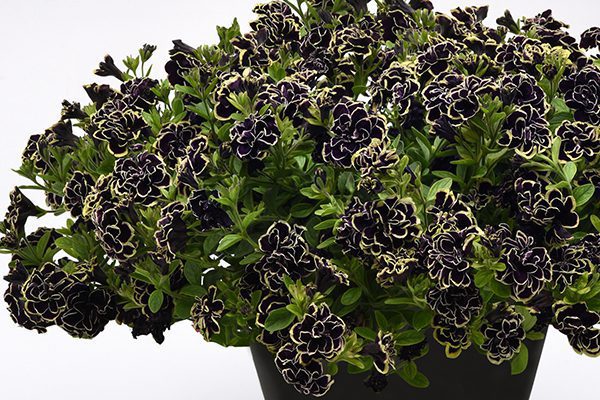Petunia, Double Midnight Gold
$8.99
Discount per quantity
| Quantity | 3 - 8 | 9 - 14 | 15+ |
|---|---|---|---|
| Price | $8.72 | $8.45 | $8.09 |
| % Discount | 3% | 6% | 10% |
Description
Double Midnight Gold Petunia: Bold Color, Endless Charm
Every garden tells a story. Some flowers whisper, while others shout. Double Midnight Gold petunia sings a rich, low song and then surprises us with bright, golden notes. The plant’s velvet-dark blooms unfold in fluffy, double layers. Each petal edge glows like a ring of sunlight. You see drama, elegance, and a hint of magic all at once. In other words, you get the night sky and sunrise in one flower.
This guide invites you to explore every bright detail. We will look at what makes this variety special, and we will walk step-by-step through simple care. By the end, you will feel ready to tuck Double Midnight Gold into pots, baskets, or beds and watch it thrive all season long.
Description
Layered Blooms That Steal the Show
Double Midnight Gold is a true double petunia. Instead of five flat petals, each bloom carries many soft layers. The result is a ruffled, almost rose-like form. We can compare it to velvet fireworks—bursting, plush, and full. The blooms reach two to three inches wide, yet they never look heavy. They float above the foliage like small satin pompoms.
Color That Dances with Light
The main petal surface is a deep, inky purple, so dark that it can read as black on cloudy days. Along every ruffled edge, a bright golden-yellow band glows. The contrast is striking from a distance and breathtaking up close. After more than a few minutes in the sun, you may notice subtle maroon hints or tiny sparkles of silver. Instead of one flat color, this variety shifts tone through the day, giving fresh interest morning to evening.
Compact, Mounding Habit
You will not have to worry about lanky stems. Plants remain tidy, round, and bushy, staying 10–12 inches tall with a 18-inch spread. That shape makes it perfect for containers, window boxes, and border fronts. Spreading petunias often sprawl, but Double Midnight Gold balances width and height, creating a rich cushion of bloom without bare centers.
A Welcome Mat for Pollinators
While many modern double petunias lose scent, this one keeps a light, sweet fragrance. Bees, small butterflies, and even curious hummingbirds visit often. The extra petals give them landing pads. In other words, you are not only planting beauty; you are setting a table for helpful garden guests.
Season-Long Performance
Once warm weather arrives, flowering begins and seldom pauses. Continuous bloom power comes from modern breeding that blends vigorous growth with heat tolerance. With regular feeding, you will enjoy flowers from late spring until the first hard frost. Deadheading helps, but even without perfect care, new buds push through.
How to Care For Double Midnight Gold
1. Light: Chase the Sun
Full sun is best. Aim for six or more hours of direct light each day. Morning sun plus light afternoon shade works in very hot regions. Too much shade leads to fewer blooms and stretched stems. Instead of guessing, watch the plant. If it leans toward light or flowering slows, move the container or trim nearby branches.
2. Soil: Loose, Rich, and Well-Drained
Petunias dislike soggy feet. Choose a light potting mix for containers or amend ground beds with compost and perlite. Soil pH near neutral (6.0–7.0) lets plants absorb nutrients. Heavy clay? Build raised beds or mix in aged pine bark to open the texture. Poor soil drains fast, so blend in organic matter to hold moisture without waterlogging.
3. Watering Rhythm: Moist, Not Wet
Water deeply when the top inch feels dry. In containers, test daily during peak summer. Morning watering is best, giving leaves time to dry before dusk. Saturate the root zone until excess drains. Instead of quick splashes, slow soaks encourage deep roots. Avoid overhead watering late in the day to limit fungal spots on the petals.
4. Feeding for Endless Blooms
Petunias are hungry bloomers. Start with a slow-release granular fertilizer mixed into soil at planting. Every two weeks, follow with a balanced, water-soluble feed (for example, 20-10-20). But most of all, watch plant signals. Pale leaves mean more nitrogen; smaller blooms hint at low phosphorus. A trace-element supplement once a month keeps colors bold.
5. Pinching and Deadheading: Shape and Spark
When young plants reach six inches tall, pinch the top inch. This simple step triggers side shoots, thickening the mound. Spent flowers turn sticky and brown. Snip them off with a short piece of stem attached. In other words, clean up keeps energy flowing to new buds. If time is short, shear the whole plant by one-third mid-season; fresh blooms follow fast.
6. Pest Patrol: Stay Ahead, Stay Calm
Aphids, thrips, and whiteflies sometimes visit. Inspect undersides of leaves every week. You can blast small pests off with a gentle water spray. In heavier cases, apply insecticidal soap early in the morning. Fungal spots appear in humid weather; treat with a copper-based fungicide if needed. Healthy, well-spaced plants shrug off most problems, so focus on strong culture first.
7. Weather Smarts: Heat and Cool
Double Midnight Gold loves warmth but melts in extreme heat over 95 °F. Afternoon shade or extra water can help. Unexpected cold snaps below 40 °F may stall growth. If frost threatens, cover with fabric or move pots indoors overnight. After more than one cold night, keep plants sheltered until steady warmth returns.
8. Overwintering and Propagation
Petunias are tender perennials but act as annuals in temperate zones. You can root tip cuttings in late summer. Dip cut ends in rooting hormone, place in moist, sterile mix, and keep under bright light. Once roots form, grow the young plants indoors under lights through winter. This saves money and lets you share rare colors with friends.
9. Companion Planting: Build a Harmony
Pair the deep, dark petals with silver foliage like dusty miller or licorice plant. The gold edge pops beside chartreuse sweet potato vine. For vertical lift, add dracaena spikes or purple fountain grass. Instead of competing colors, choose accents that echo either gold or midnight tones. The result feels planned and peaceful.
10. Design Ideas: From Porch to Pathway
- Thriller in Mixed Pots – Center a 14-inch planter with Double Midnight Gold, ring it with golden creeping jenny, and let trailing verbena spill over the sides.
- Elegant Window Box – Alternate clumps of Double Midnight Gold with white bacopa for high contrast.
- Bold Ground Cover – Mass several plants along a sunny path for a rolling wave of velvet and gold.
- Evening Patio Accent – Position pots near seating areas. The dark petals look deeper as daylight fades, while the golden rims keep glowing.
11. Simple Troubleshooting Chart
| Symptom | Likely Cause | Quick Fix |
|---|---|---|
| Pale leaves | Low nutrients | Feed with balanced liquid food |
| Few blooms | Not enough sun | Move to brighter spot |
| Sticky buds | Budworm caterpillars | Hand-pick or use Bt spray |
| Wilting despite wet soil | Root rot | Improve drainage, reduce watering |
12. Kid-Friendly Fun
Children can help pinch tips and count new flowers. They will love tracing the golden outlines. Use a magnifying glass to spot fine hairs on the petals. Gardening becomes a shared adventure, teaching care and patience.
13. Sustainable Steps
Collect rainwater for irrigation. Mix compost from kitchen scraps into potting soil. Choose organic pest controls first. After more than one season, you will notice richer soil and stronger bloom power. Small, steady habits build a greener garden.
14. Frequently Asked Questions
Will heavy rain damage the blooms?
The double form is dense, so petals may hold water. Shake branches gently after storms to help them dry.
Can I grow it indoors?
Yes, under bright grow lights for 14–16 hours daily. Use a fan for air flow and prune to maintain shape.
How often should I repot?
If roots circle the container or water runs off quickly, step up to a pot two inches wider. Early summer is best.
Shining Onward Together
Double Midnight Gold petunia gives us the thrill of contrast—night-dark petals and golden halos—in every bloom. Caring for it is easy once you understand its simple needs: sun, good soil, steady food, and thoughtful pruning. We plant it, we tend it, and it rewards us with months of rich color. Most of all, it reminds us that a single flower can carry both mystery and light. Let’s celebrate that shimmering balance in our gardens this year and in every season that follows.
Additional information
| Weight | N/A |
|---|---|
| Options | Starter Plug – 3 count, 4 in. (16.9 fl. oz.) Pot |





